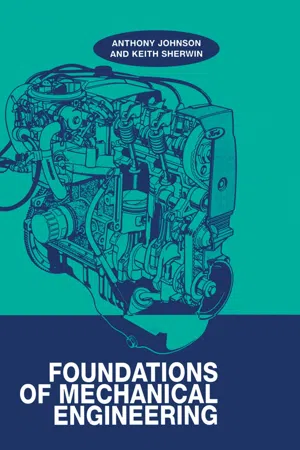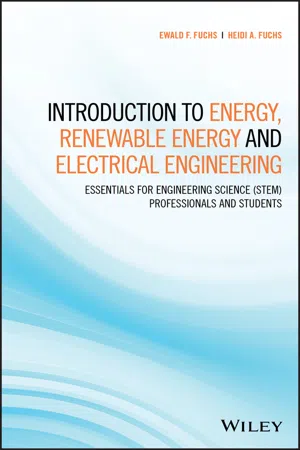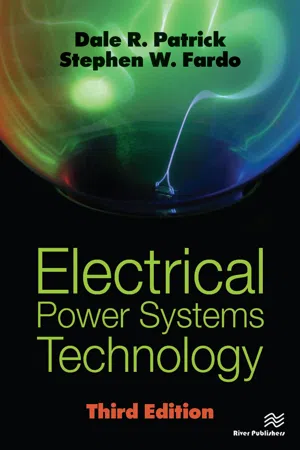Physics
Power Rating
Power rating refers to the measure of the rate at which work is done or energy is transferred. In physics, it is typically expressed in watts and is used to quantify the amount of energy consumed or produced per unit of time. Power rating is crucial in determining the performance and efficiency of various mechanical and electrical systems.
Written by Perlego with AI-assistance
Related key terms
Related key terms
1 of 4
Related key terms
1 of 3
4 Key excerpts on "Power Rating"
- eBook - ePub
- A. D. Johnson(Author)
- 2017(Publication Date)
- CRC Press(Publisher)
When describing the energy output of, say, an internal combustion engine or a turbine, the word ‘power’ is often loosely applied. It may be said that the engine is ‘powerful’, but this refers to mechanical output power.The term ‘power’ may be considered in a number of different ways and depends upon how the power is generated, stored and used. For instance, chemical ‘power’ is stored as petrol and is released when petrol is burned. The rate of heat generated may be measured in watts (the unit of power). Petrol, of course, is burned in an internal combustion engine, which has a mechanical output power, also measured in watts.Electricity is generated by forcing high-temperature steam through a turbine. The ‘power’ possessed by the steam turns the turbine which, in turn, drives the generator, thus producing the electricity. This can also be measured in watts. The electrical power can be used to turn an electric motor which converts it back into mechanical power.Whatever the means of conversion or generation, the power developed is measured in watts, and if losses are ignored, the power possessed by one medium can be converted to, and used in, another medium.Power is the rate of doing work. The base unit of power is the joule/s, designated J/s, and, in mechanical terms, can be defined by considering: 1 N moved through 1 m in 1 s, so that the unit of power is J/s = W .This can be explored further by considering equation (5.1) :w = F × sDividing both sides by time givesbutw t= F ×s t ( 5.13 )ands t= velocity, υw t= power, Pso that equation (5.13) can be rewritten:Convention dictates that the unit of J/s is redesignated as the watt or W. The watt is often found to be too small to be used effectively and so other derivatives are used such as:w = F × vJ / sor W ( 5.14 )Often the amount of power used is measured for a period of time. For instance, domestic electricity is measured in kilowatt-hours.kilowatt = 1000 Wmegawatt = 1 000 000 W - eBook - ePub
- Adrian Waygood(Author)
- 2018(Publication Date)
- Routledge(Publisher)
very small unit of measurement, power utility companies charge their customers for the energy they use in kilowatt hours. A kilowatt hour is simply a ‘big’ version of the joule. How much bigger? Well, as we shall learn later, it’s equivalent to 3.6 MJ.Power: the watt
As power is the rate of doing work (or of heat transfer ), it follows that its unit of measurement is the joule per second . However, in common with many other SI derived units, this unit is given a special name: the watt (symbol: W ), named in honour of the Scottish engineer, James Watt. So a ‘watt’ is just another way of saying, ‘joule per second’.You should be aware that the imperial unit of measurement of power is the horsepower (symbol: HP ). Although the horsepower has been phased out in the United Kingdom since the adoption of SI, you may come across older electric motors whose nameplates specify their rated power output in horsepower, rather than in watts. To convert horsepower to watts:1 HP = 746 WYou have probably noticed that car engines are now rated in kilowatts, rather than in horsepower. Some books refer to ‘horsepower’ being used to measure ‘mechanical power’ but, as we have learnt, there is really no such thing as ‘mechanical power’, ‘electrical power’, etc!There is absolutely no reason why you shouldn’t measure the power of an electric fire in horsepower – in fact, a ‘three-bar 3-kW electric fire’ could just as correctly be called a ‘three-bar 4-horsepower electric fire’!Energy, work, heat and power in electric circuits
In Chapter 5 , we learnt that the volt is defined as ‘the potential difference between two points such that the energy used in conveying a charge of one coulomb from one point to the other is one joule’ - eBook - ePub
Introduction to Energy, Renewable Energy and Electrical Engineering
Essentials for Engineering Science (STEM) Professionals and Students
- Ewald F. Fuchs, Heidi A. Fuchs(Authors)
- 2020(Publication Date)
- Wiley(Publisher)
p measured in volt‐amperes (VA) or watts.1.8.1 Electric Charge
If an electron leaves its parent atom, it becomes a free electron and leaves behind a “hole”; that is, the parent atom becomes an ion or a positive charge carrier. An electron has the charge qo = 1.6020 · 10−19 As. A capacitor can temporarily store electrons that are endowed [49 ] with voltage v as shown in Figure 1.14 a. For example, rubbing a plastic ruler on fabric can charge a capacitor with endowed electrons, thus converting free electrons into endowed electrons that are capable of useful work. The endowed electrons can then be discharged by connecting a resistor across the capacitor as illustrated in Figure 1.14 b. Thus, the endowed electrons heat up the resistor by discharging, and endowed electrons become free electrons again. This concept is applied to the generation of electric energy within power plants and transmission and distribution systems in Appendix 1.B . Note that a resistor R measured in ohms (Ω) consists of a conducting wire of length ℓ, cross section A, and resistivity ρ such that(1.12)Resistivity is a property inherent to a particular material, related to atomic interactions that hinder charge carriers’ movement due to movements of electrons into and from the valence and conduction bands of ions. Resistance of a material results from friction‐like interactions between electrons or ions in motion and other material particles. A substance’s molecular makeup and form determine its resistance. For example, in a wire, resistance declines with cross‐sectional area and rises with the length of the wire; however, it increases with temperature.The symbol of a capacitor should not be confused with that of a normally open and closed relay switch as is depicted in Figure 1.4 c and d. Unfortunately many textbooks use the wrong symbol (see Figure 1.14 - Dale R. Patrick, Stephen W. Fardo(Authors)
- 2020(Publication Date)
- River Publishers(Publisher)
The energy transformation process of a flashlight is irreversible. It starts at the battery when chemical energy is changed into electrical energy. Electrical energy is then changed into heat energy and eventually into light energy by the load device. This flow of energy is in a single direction. When light is eventually produced, it consumes a large portion of the electrical energy coming from the source. When this energy is exhausted, the system becomes inoperative. The battery cells of a flashlight require periodic replacement in order to maintain a satisfactory operating condition.Flashlights do not ordinarily employ a specific indicator as part of the system. Operation is indicated when the lamp produces light. In a strict sense, we could say that the load of this system also serves as an indicator. In some electrical systems the indicator is an optional system part.ENERGY, WORK, AND POWER
An understanding of the terms “energy,” “work,” and “power” is necessary in the study of electrical power systems. The first term, “energy,” means the capacity to do work. For example, the capacity to light a light bulb, to heat a home, or to move something requires energy. Energy exists in may forms, such as electrical, mechanical, chemical, and heat. If energy exists because of the movement of some item, such as a ball rolling down a hill, it is called kinetic energy. If energy exists because of the position of something, such as a ball that is at the top of the hill but not yet rolling, it is called potential energy. Energy is one of the most important factors in our society.A second important term is “work.” Work is the transferring or transforming of energy. Work is done when a force is exerted to move something over a distance against opposition, such as when a chair is moved from one side of a room to the other. An electrical motor used to drive a machine performs work. Work is performed when motion is accomplished against the action of a force that tends to oppose the motion. Work is also done each time energy changes from one form into another.
Index pages curate the most relevant extracts from our library of academic textbooks. They’ve been created using an in-house natural language model (NLM), each adding context and meaning to key research topics.
Explore more topic indexes
Explore more topic indexes
1 of 6
Explore more topic indexes
1 of 4



